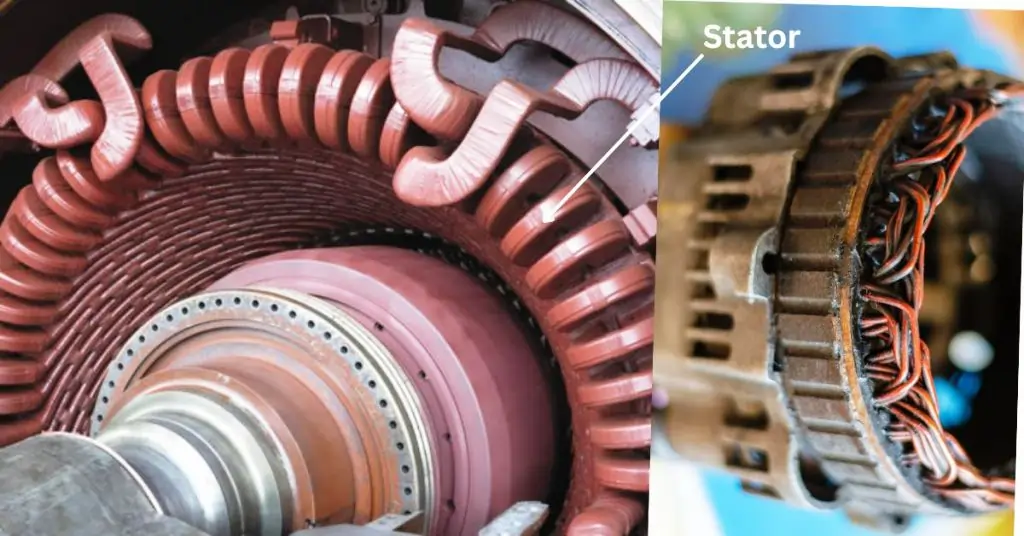Stators
The stators are the critical component in electric generators, playing a pivotal role in converting mechanical energy into electrical energy. Understanding the stator’s function and design is essential for anyone looking to optimize generator performance and efficiency. This knowledge not only helps in improving power output but also in maintaining and troubleshooting generators effectively.
In this blog post, we will delve into the top 5 most amazing key insights about the stator that can significantly boost your generator’s power. From the basics of how the stator works, to the latest innovations in stator technology, and practical maintenance tips, we’ve got you covered. By the end of this post, you’ll have a comprehensive understanding of the stator’s impact on electric generator performance and be equipped with actionable insights to enhance your generator’s efficiency and reliability.
Understanding the Stator
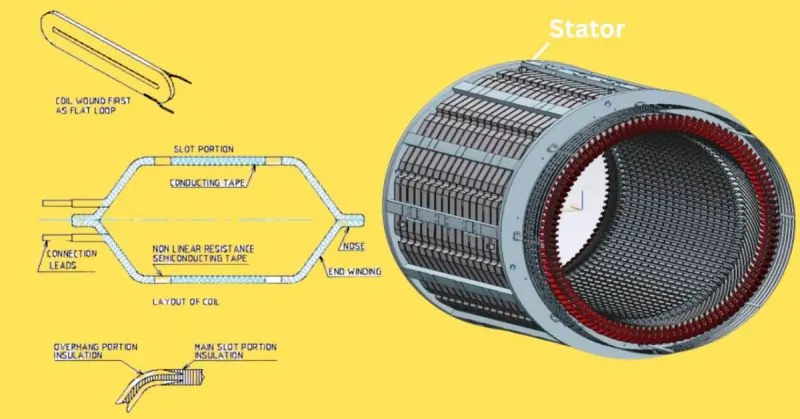
The stator is a fundamental component in electric generators, serving as the stationary part that works in conjunction with the rotor to generate electricity. It plays a pivotal role in converting mechanical energy into electrical energy, ensuring the efficient functioning of the generator. This detailed description delves into the definition, basic function, and role of the stator, its construction, and the differences between the stator and rotor.
Definition and Basic Function of the Stator
The stator consists of a set of coils or windings made typically of copper or aluminum, fixed in place around the inner circumference of the generator. The primary function of the stator is to create a magnetic field that interacts with the rotor. This interaction induces an electromotive force (EMF), which is essential for the conversion of mechanical energy into electrical energy. The stator remains stationary, providing a stable magnetic environment for the rotor to move through, thereby generating electricity.
Role of the Stator in an Electric Generator
In an electric generator, the stator plays a critical role in power generation. As the rotor spins within the magnetic field produced by the stator, it cuts through the magnetic lines of force. This motion induces a voltage in the stator windings, resulting in an alternating current (AC). The efficiency and performance of the generator depend significantly on the design and condition of the stator, as it directly influences the strength and stability of the generated magnetic field.
The stator’s ability to produce a consistent and strong magnetic field is crucial for ensuring the generator’s steady and reliable electricity supply. Innovations in stator design, such as improvements in winding configurations and the use of advanced materials, have significantly enhanced the performance and efficiency of modern generators.
Construction of the Main Stator
The main stator of an electric generator consists of several critical assemblies: the stator core assembly, stator winding assembly, and stator frame.
Stator Core Assembly
The stator core is built with laminated silicon steel sheets of high quality and low iron loss. These sheets are welded with duct pieces at suitable intervals along the axial direction, forming ventilating ducts that effectively cool the interior. The stator core is tightened and fitted with ample pressure using core clamps and bolt assemblies or landing bar assemblies, depending on design requirements. This ensures stability and efficiency in the generator’s operation.
Stator Winding Assembly
The three-phase stator winding is designed as a two-layer lap winding, with coils grouped according to the number of slots per pole per phase. The stator coils are of the pulled winding type, insulated with mica tape, and coated with a special finish that resists heat, humidity, and oil. The end bends of the stator coils are supported by fiberglass support rings on both ends, protecting the winding from mechanical forces due to vibration and overcurrent. Harmonic distortions, magnetic noises, and vibrations on the lamination core are addressed during the design stage. Additionally, the stator undergoes vacuum pressure impregnation, resulting in high mechanical and electrical strength.
Stator Frame
The outer frame of the stator is constructed from high-quality steel, fabricated and welded to offer a strong and rigid structure. The stator winding forms the main part, which is either pressed or inserted into the frame. Two rectangular steel plates are bolted to form the generator feet, or the complete frame assembly is mounted on a base frame, depending on customer requirements. For diesel generator applications, the entire machine is typically mounted on the customer’s common base frame.
Differences Between the Stator and the Rotor
While the stator is the stationary part of the generator, the rotor is the moving component that spins inside the stator. Key differences include:
- Position and Movement: The stator remains fixed, while the rotor rotates within the stator.
- Function: The stator generates the magnetic field, whereas the rotor cuts through this field to induce voltage.
- Construction: The stator consists of multiple windings arranged in a fixed position, while the rotor is typically a shaft with attached magnetic poles or a set of windings that create a rotating magnetic field.
Essential Stator Formulas for Electric Generators
1. Stator Induced EMF Formula
This formula is derived from Faraday’s Law and represents the voltage generated in the stator windings due to the rotating magnetic field produced by the rotor. It is directly proportional to the frequency of the AC supply, the number of turns in the winding, and the magnetic flux.
The induced electromotive force (EMF) in the stator windings can be calculated using Faraday’s Law of Electromagnetic Induction:
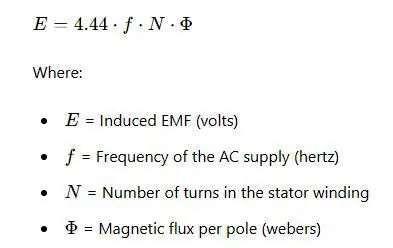
Stator Magnetic Flux Density Formula
This formula calculates the magnetic flux density in the stator core. It is a measure of how much magnetic flux is concentrated in a given area of the core, which affects the efficiency of the energy conversion process.
The magnetic flux density in the stator core can be determined using the following formula:
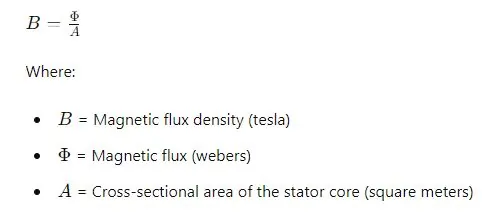
3. Stator Current Formula
This formula uses Ohm’s Law to determine the current flowing through the stator windings. It is essential for understanding the electrical load on the stator and ensuring it operates within safe limits.
The current in the stator windings can be calculated using Ohm’s Law, considering the resistance of the windings and the induced EMF:
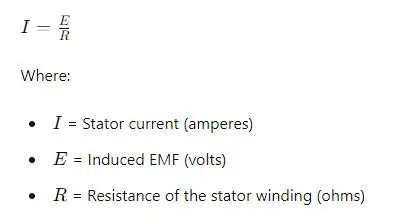
How the Stator Contributes to Power Generation
The stator is an essential component in the process of generating power in electric generators. It works through the principles of electromagnetic induction, interacting with the rotor to convert mechanical energy into electrical energy. Here’s a detailed look at how the stator contributes to power generation:
Explanation of Electromagnetic Induction
Electromagnetic induction is the process by which a change in magnetic field within a conductor induces an electromotive force (EMF) or voltage. This fundamental principle, discovered by Michael Faraday, is the basis for the operation of electric generators. In a generator, as the rotor turns, it creates a dynamic magnetic field that interacts with the stator windings. This interaction generates an alternating current (AC) in the stator windings.
Interaction Between the Stator and Rotor
The interaction between the stator and rotor is central to the generation of electricity. The rotor, connected to a mechanical power source, spins within the stator. As it rotates, the magnetic field generated by the rotor’s magnets or windings passes through the stator windings. This movement creates a relative motion between the magnetic field and the stator conductors, inducing a voltage in the stator windings due to electromagnetic induction.
The stator is designed to remain stationary, providing a stable structure for the rotor to rotate within. The efficiency of this interaction depends on the precision and quality of the stator’s construction, including the material and configuration of its windings. A well-designed stator ensures a strong and consistent magnetic field, optimizing the voltage induced in the windings.
Conversion of Mechanical Energy to Electrical Energy
The process of converting mechanical energy to electrical energy in a generator involves several steps:
- Mechanical Input: The rotor receives mechanical energy from an external source, such as a turbine or an engine.
- Magnetic Field Generation: As the rotor spins, it creates a magnetic field that moves through the stator windings.
- Induced Voltage: The movement of the magnetic field relative to the stator windings induces an electromotive force (EMF) in the conductors, according to Faraday’s Law of Electromagnetic Induction.
- Electrical Output: This induced voltage causes an alternating current (AC) to flow in the stator windings. The AC output can then be harnessed for various applications, from powering homes and businesses to running industrial machinery.
The efficiency of this energy conversion process is heavily influenced by the design and quality of the stator. Factors such as the type of winding, the materials used, and the overall construction of the stator all play a significant role in determining the generator’s performance.
Key Design Features of an Efficient Stator
The efficiency of a stator in an electric generator is determined by several key design features. These include the materials used in its construction, the configuration of its windings, and recent innovations aimed at enhancing performance. Here’s a detailed look at these critical aspects:
Materials Used in Stator Construction
The choice of materials is crucial for the efficiency and longevity of a stator. High-quality materials reduce energy losses and improve the overall performance of the generator.
- Laminated Silicon Steel: The core of the stator is typically made from laminated silicon steel sheets. These sheets are designed to minimize eddy current losses and reduce magnetic hysteresis, both of which can significantly impact efficiency. The laminations are thin and insulated from each other to limit the circulation of eddy currents.
- Copper Windings: The stator windings are generally made from copper due to its excellent electrical conductivity. Copper minimizes resistive losses and enhances the efficiency of electrical energy transfer. In some cases, aluminum may be used as a cost-effective alternative, although it is less efficient than copper.
- Insulating Materials: High-quality insulation materials, such as mica tape, are used to insulate the windings. These materials must withstand high temperatures, humidity, and mechanical stresses without degrading.
- Support Structures: Components like fiberglass support rings are used to provide mechanical support to the windings, protecting them from vibrations and mechanical forces that could cause damage or misalignment.
Importance of Stator Winding Configurations
The configuration of the stator windings plays a significant role in determining the efficiency and performance of the generator. Proper winding design ensures optimal electromagnetic interaction and minimizes losses.
- Two-Layer Lap Winding: This is a common configuration where each coil overlaps the previous one in two layers. This design helps distribute the magnetic field evenly and reduces harmonics, leading to smoother and more efficient operation.
- Slot Per Pole Per Phase: The stator windings are arranged in slots, with the number of slots per pole per phase being a critical factor. This arrangement influences the magnetic flux distribution and the overall efficiency of the generator.
- Winding Insulation and Coating: The windings are insulated and coated with materials that offer resistance to heat, humidity, and oil. This insulation is crucial for preventing short circuits and maintaining the integrity of the windings under various operating conditions.
Innovations in Stator Design for Improved Efficiency
Advancements in technology and materials have led to significant innovations in stator design, further enhancing the efficiency and reliability of electric generators.
- Vacuum Pressure Impregnation (VPI): This process involves impregnating the stator windings with resin under vacuum pressure. VPI improves the mechanical and electrical strength of the windings, enhances thermal conductivity, and provides better protection against environmental factors.
- Advanced Magnetic Materials: The use of advanced magnetic materials with lower core losses and higher magnetic permeability has improved the efficiency of stators. These materials reduce energy losses during the magnetization and demagnetization cycles of the generator’s operation.
- Cooling Systems: Innovations in cooling systems, such as integrated duct pieces and optimized airflow designs, have significantly improved the cooling efficiency of stators. Effective cooling systems prevent overheating, maintain optimal performance, and extend the lifespan of the generator.
- Modular Design: Modular stator designs allow for easier assembly, maintenance, and scalability. This approach not only enhances manufacturing efficiency but also enables quick repairs and upgrades, reducing downtime and operational costs.
- Smart Monitoring and Diagnostics: The integration of sensors and smart monitoring systems allows for real-time diagnostics of the stator’s performance. These systems can detect anomalies, predict maintenance needs, and optimize operation, leading to increased efficiency and reduced unexpected failures.
Maintenance Tips for Optimal Stator Performance
Maintaining the stator in an electric generator is essential for ensuring its optimal performance and longevity. The table below provides detailed information on common issues affecting stator performance, regular maintenance practices, and troubleshooting and repair tips.
| Aspect | Description |
|---|---|
| Common Issues | |
| Overheating | Excessive heat can damage the insulation and windings, reducing efficiency and lifespan. |
| Vibration | Mechanical vibrations can cause physical damage to the stator and misalignment of windings. |
| Insulation Degradation | Over time, insulation materials can degrade, leading to short circuits and reduced performance. |
| Contamination | Dust, dirt, and moisture can infiltrate the stator, causing electrical shorts and corrosion. |
| Regular Maintenance | |
| Visual Inspections | Regularly check for signs of wear, damage, and contamination. Look for cracks, discoloration, and debris. |
| Cleaning | Keep the stator clean from dust, dirt, and moisture. Use dry air blowers or vacuum cleaners as needed. |
| Lubrication | Ensure that all moving parts, such as bearings, are properly lubricated to reduce friction and wear. |
| Tightening Connections | Regularly inspect and tighten all electrical connections and mechanical fasteners. |
| Insulation Testing | Perform regular insulation resistance tests to ensure the integrity of the stator windings. |
| Troubleshooting & Repair | |
| Overheating Solutions | Check ventilation systems and clean air ducts. Ensure proper cooling and reduce load if necessary. |
| Vibration Solutions | Inspect and replace worn bearings. Ensure proper alignment of the stator and rotor. |
| Insulation Repairs | Reapply or replace insulation materials on damaged windings. Use high-quality insulation tapes and coatings. |
| Contamination Solutions | Clean the stator thoroughly and use protective covers. Ensure the generator is in a clean, dry environment. |
| Electrical Testing | Use multimeters and megohmmeters to test for continuity and resistance. Identify and repair short circuits. |
| Professional Assistance | For complex issues, consult with a professional technician or service provider. Regularly schedule professional inspections. |
Future Trends in Stator Technology
The future of stator technology in electric generators is poised for significant advancements, driven by innovations in materials, design, and overall efficiency improvements. Here, we explore the emerging trends, the impact of technological innovations, and predictions for the future of stator technology.
Advances in Stator Materials and Design
The continuous evolution in materials science and engineering is leading to remarkable improvements in stator construction.
- Advanced Magnetic Materials: The development of new magnetic materials, such as high-performance ferrites and rare-earth magnets, is reducing energy losses and enhancing magnetic flux density. These materials offer better efficiency and higher power output for generators.
- Nanomaterials: The incorporation of nanomaterials into stator construction can significantly improve electrical conductivity and thermal management. Nanotechnology allows for the creation of materials with superior properties, such as higher strength and reduced weight, which contribute to better performance and durability.
- Composite Materials: The use of composite materials in stator frames and cores is becoming more prevalent. These materials provide excellent mechanical strength, corrosion resistance, and reduced weight, which contribute to the overall efficiency and longevity of the stator.
- 3D Printing: Additive manufacturing, or 3D printing, is revolutionizing stator design by enabling the creation of complex geometries and custom components that are difficult to achieve with traditional manufacturing methods. This allows for optimized designs that enhance performance and reduce material waste.
Impact of Technological Innovations on Stator Efficiency
Technological innovations are significantly impacting the efficiency and performance of stators in electric generators.
- Enhanced Cooling Systems: Innovations in cooling technologies, such as advanced liquid cooling and optimized airflow designs, are improving heat dissipation in stators. Efficient cooling systems prevent overheating, maintain optimal performance, and extend the lifespan of the generator.
- Smart Monitoring and Control: The integration of smart sensors and control systems allows for real-time monitoring of stator performance. These systems can detect anomalies, predict maintenance needs, and optimize operation, leading to increased efficiency and reduced downtime.
- High-Efficiency Winding Techniques: Advanced winding techniques, such as precision winding and automated coil insertion, are improving the consistency and quality of stator windings. These techniques reduce electrical losses, enhance magnetic performance, and ensure uniformity in production.
- Vacuum Pressure Impregnation (VPI): The VPI process enhances the mechanical and electrical properties of stator windings by impregnating them with resin under vacuum pressure. This results in improved insulation, higher mechanical strength, and better resistance to environmental factors.
Predictions for the Future of Stator Technology in Electric Generators
The future of stator technology promises to bring even more exciting advancements that will shape the next generation of electric generators.
- Integration with Renewable Energy Systems: As the demand for renewable energy sources grows, stator technology will increasingly focus on integration with solar, wind, and hydroelectric power systems. Stators designed for these applications will need to be highly efficient, durable, and capable of handling variable power inputs.
- Artificial Intelligence and Machine Learning: The use of AI and machine learning algorithms in the design and optimization of stators will become more prevalent. These technologies can analyze vast amounts of data to identify patterns, optimize designs, and predict maintenance needs, leading to smarter and more efficient generators.
- Sustainable Materials and Processes: There will be a greater emphasis on using sustainable materials and environmentally friendly manufacturing processes. This includes the development of biodegradable insulation materials, recyclable composites, and energy-efficient production techniques.
- Higher Power Density and Miniaturization: Future stators will likely achieve higher power density, allowing for more compact and lightweight generators. Advances in materials and design will enable the creation of stators that deliver higher performance in smaller form factors, making them ideal for a wide range of applications.
FAQ on “Stators”
Q: What is the main function of a stator in an electric generator?
A: The stator creates a magnetic field that induces voltage in the rotor.
Q: How does a stator differ from a rotor?
A: The stator is stationary, while the rotor rotates within it.
Q: What materials are commonly used in stator construction?
A: Stators are typically made from laminated silicon steel and copper windings.
Q: Why is regular maintenance of the stator important?
A: Regular maintenance ensures optimal performance and prevents issues like overheating and insulation degradation.
Conclusion
Understanding the role and design of the stator in electric generators is crucial for optimizing power generation. The stator’s construction, materials, and innovations significantly impact the efficiency and reliability of generators. As technology advances, we can expect even greater improvements in stator design, enhancing the performance of power systems. Regular maintenance and staying informed about future trends will ensure that your generators remain efficient and reliable. Embracing these advancements will pave the way for a more sustainable and powerful energy future.
